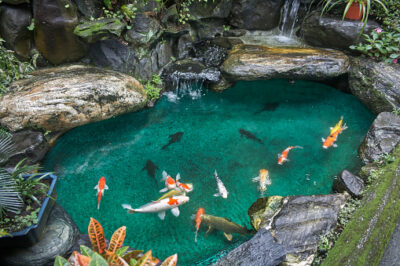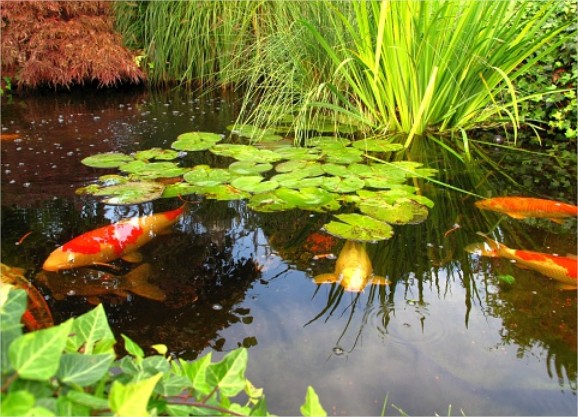
Keeping a pond in the garden might be an easy task but maintaining it in a healthy way is the real success of any pond keeper. What if you see your fish immersed in green cloudy water? It obviously will be esthetically unpleasant for you and the visitors. Before finding the methods to clean your pond naturally, one must be aware of the causes that make your pond dirty. The main reasons behind the clarity issues of the pond can be algae growth (single-celled or string), leaves, debris, etc. They can easily discolor your pond water and degrade its quality. Once you find out the culprits of your pond’s hygiene, foster the methods you can use to get rid of them. One always wants to keep his pond clear and clean without using toxic chemicals. Natural methods are always long-lasting, low-cost, and is always safe. This article will let you know about some nature-derived methods, which all pond owners surely want to know. So here is the list:
Use of Barley straw

Since algae are the primary reason for making your pond green, Barley straws are the best natural source to inhibit algae growth. Barley straw is a natural product obtained as a result of barley grain production. It is cheap to buy and will not harm your fish and plants. Barley straw, when deposited in the pond, starts to decompose and releases such chemicals that contribute to obstructing algae growth. Barley straws are available in liquid form, bales, as well as in pellets too. If your pond owns a waterfall, you can hang the barley straw bales in it. You can wrap the straw bales into something like a net so they won’t get dispersed on the surface. Keep in mind that cleaning the pond using barley straws can take a little bit more time as compared to toxic chemicals as barley straws take a few weeks to start decomposing. So do not worry if you are not getting the required results instantly. Once they start decomposing, the bundle will sink and would no longer be visible on the water’s surface. According to Pennsylvania State University’s website, it is advised to use 10 to 25 grams of barley straw for every square meter of a pond. However, initially, you may need to use three times the such amount if your pond is facing a severe algae problem.
Add beneficial bacteria
Another secret to making the water clear naturally is to add beneficial bacteria to the pond. This bacteria will consume all of the nitrites present in the pond and starve the algae; hence hindering algae from further growth. These bacteria are eco-friendly and act as a natural helper and you do not have to worry about their excess use, unlike algaecides. Its overdose will not harm your pond or fish and is safe to use. You can manually add bacteria to the pond or you can use an auto dose that will do it for you. The amount to be added to the pond depends upon the size of your pond. It also depends upon the type of product you are using whether the beneficial bacteria are in tablet or liquid form. Mostly it is enough to add biodegradable bacteria once a month to keep your pond clear and clean. When buying beneficial bacteria from the market, keep in mind that its packaging is mentioning:
- Natural ingredients
- Have a high amount of active bacteria
- Contains aerobic and anaerobic bacteria both
Add aquatic plants and scavengers
A small amount of algae in the pond is of no concern but if it is taking over the health of the ecosystem then we must do some remedies. Adding aquatic plants to the pond is another approach to keeping the pond naturally clean. Such plants will enhance the beauty of your pond as well as it also restricts the algae growth in your pond. You can add floating plants, submerged plants, or marginal plants to control algae bloom. These plants will help in consuming nitrates and therefore compete with the algae growth. Algae grow in sunlight. Using water lilies will provide 30% to 50% shade to the pond and will assist in avoiding algae expansion. The shallow areas of the pond are usually the warmer ones and are most prone to algae growth. For providing shadow to shallow ends of the pond, “tassel cord rush” would be most suitable. When bacteria eat up algae causing nitrites, they produce nitrates. Different types of plants can eat different types of nitrates. Adding blue flowers can chomp one type; iris and pink flowers can consume another; plants blooming in May serve differently from the plants blooming in September. Make sure that these plants are not harming the environment of the pond. These plants, if introduced initially can prevent algae growth in the future. You can take suggestions from pond experts and discuss the plants suitable for your pond according to the weather and location of your pond.
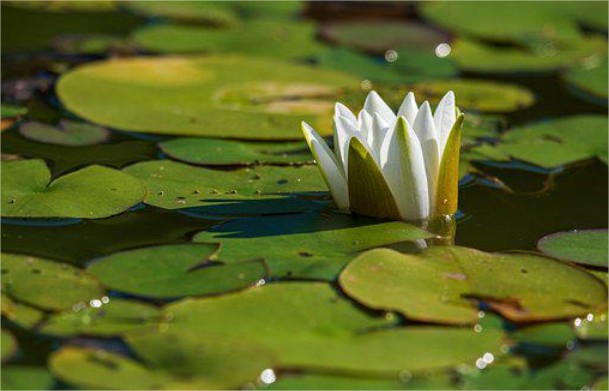
You can also add snails and tadpoles that act as scavengers and will clean the waste from the pond. Some freshwater mussels and clams are also appropriate for cleaning the pond naturally. They individually can filter approximately 16 gallons of water per day.
Do not overcrowd the pond with fish
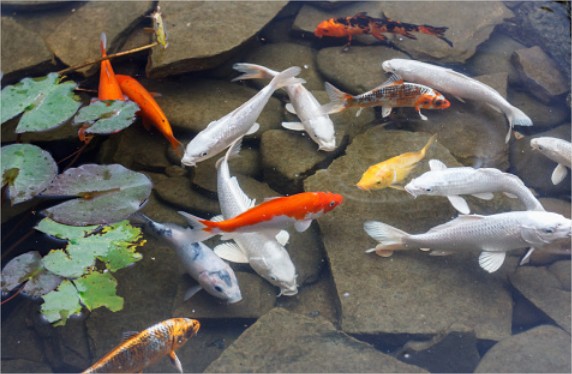
To make your pond naturally healthy and clean, the population of the pond matters a lot. As fish produces nitrogen, the more fishes in the pond mean the greater nitrogen will be produced and hence results in algae growth. An ample amount of fish in the pond can also increase the pond’s water temperature, which can drop the oxygen level of the pond. You must keep in mind that you have added the right proportion of the fish according to the size of your pond. According to experts, a balanced pond must have half inches of fish for every 10 gallons of water. Adding algae-eating fish to the pond is another natural way to keep your pond clean and clear. If still you do not know how much quantity of fish is overcrowding your pool, certain signs let you know about this:
- Frequent fish death or illness
- Too many algae despite of being adding lots of plants
- Facing difficulty in cleaning the pond water even though you are adding the regular amount of beneficial bacteria
Select a good location
If you don’t own a pond right now but are planning to make one, then this will be going to help you out. Try to build the pond at a place that can provide proper natural aeration to it. Try not to place your pond beneath a tree, as this will cover your pond with leaves and debris. If you see some leaves floating over the pond surface, immediately scoop them off before it turns rotten and becomes the source of algae. This usually happens in autumn or the windy season. Choose a place where sunlight and shade both can be easily reached as fishes need the warmth of sunlight for their growth. However, excess sunlight can induce algae growth but a few algae are not bad for aquatic life.
Aerate your pond
Another environmentally friendly method for cleaning ponds is to provide them with the proper aeration system. Aeration is the process that involves adding oxygen to water. Proper aeration provides aerobic bacteria with enough oxygen levels to survive and be active. It also minimizes insect larvae growth and expedites the decomposition of organic matter. Aeration keeps the pond free from foul odors and improves the health of fish. You must select a place where the air is easily accessible to your pond and have a proper ventilation system.
Add a moving water object

Water, when in a flowing posture, has the least chance of getting algae. For this, you can add a waterfall or fountain to your pond. The fountain can be placed at the center of the pond while you can install a waterfall at the corners of the pond. If the height of the waterfall or fountain is less than three feet you can install the pump beside the waterfall on the ground level. For having a waterfall or fountain above five feet in height, you should place the filter behind the waterfall at the distance equal to its highest point.
Clean your pond manually
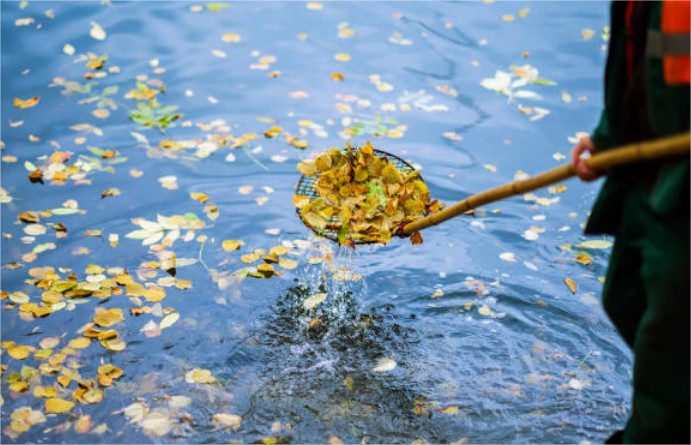
This method costs you nothing but time. Although this method involves no harmful chemicals to use nor required any heavy filters, it needs your consistency and regularity for cleaning the pond. If you do regular scooping of all the leaves and debris floating at the surface of the pond using a skimmer, they will not further decompose and will not cause algae growth. If you still see any algae, use a long stick or rake to directly take it out from the pond. For small ponds, this manual method will be more convenient for removing leaves litter. For the bottom part, you can use a wet vacuum to clean the base of the pond. This device readily sucks up all unnecessary algae, sludge, and debris and makes your pond water clear. You can also use a regular toilet brush to gather up excess algae. It is suggested to use a new toilet brush for this purpose, as fish do not like to have a used toilet brush thrust into their water.
Rinse your pond filter
This tip is very helpful because many people who own a pond already have filters in their ponds. If you have installed the filter, then think about the last time when you cleaned it out. Cleaning your pond filters once a week is the best way to obstruct algae growth. You can simply remove the filter, wash it using a spraying hose and fix it again. If you have not bought it until now, you can find it at the nearest garden supply store. This can save you from future trouble. If you observe any struggling noise or leakage from your filter, it’s time to clean it or in some cases, replace it with the new one.
Benefits of natural cleaning
Cleaning the pond using natural ways will help you to learn more about the ecosystem of your pond. You can also identify what is good and what is bad for your pond’s health. On one side where natural ways of cleaning the pond will cost you less money; it also requires patience, as these methods are effective after a long period of time. Once you observe that your natural ways are giving you fine results, they will surely be long-lasting. Taking care of your pond naturally is not a hard nut to crack and one can easily do it on his own. You just need proper time and routine for its maintenance.
In a Nutshell
A pond in a garden looks great when its water is clean and clear. The garden is the perfect place where you can sit, enjoy a cup of tea with your friends and adore the beauty of nature. However, this view can become uncomfortable if your pond water is green. So make sure you are taking care of your pond regularly and following each cleaning step described in this article. These tips will surely help you in making your pond clean in a natural way and will save a lot of time as these techniques are not time-consuming.







